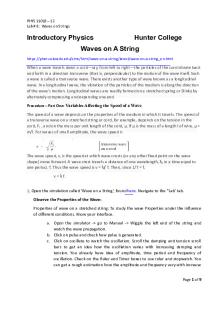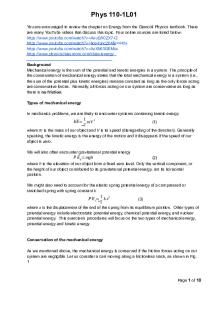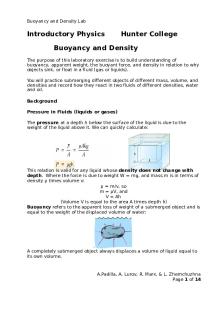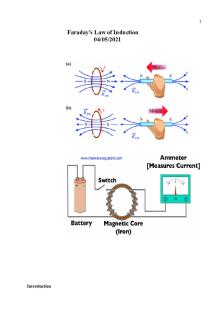Phys 208 Lab Report # 3 PDF

| Title | Phys 208 Lab Report # 3 |
|---|---|
| Course | General Physics |
| Institution | The City College of New York |
| Pages | 3 |
| File Size | 110.3 KB |
| File Type | |
| Total Downloads | 16 |
| Total Views | 179 |
Summary
lab report...
Description
Lab #3: Diffraction Grating and Interference
Introduction: In this lab, the experiment performed was a study of diffraction and interference of light wave. The purpose of our experiment was to determine the different wavelengths of visible spectral light from a diffraction grating using a spectrometer. Diffraction is a phenomenon that occurs when light travels through a barrier such as a slit in a wall and bends by a certain degree according to the size of the slit. Additionally, we measured the wavelength of a monochromatic light using the thin film effect. This gives off an interference pattern, which is useful for the calculation of the monochromatic light.
Procedure:
Part I: The Grating Spectrometer: 1) First we adjusted the grating spectrometer and made sure it was at the appropriate height with the mercury light. We made sure that what we were looking at was sharp and clear. 2) Once everything was set, we found the color bands and the angle using the Vernier scale. 3) Once we recorded everything down, we use the equation n*lambda = D*sin (theta), where lambda is wavelength and (theta) is the angle, to find the wavelength. 4) After we found the wavelength, we repeated the previous steps for different color schemes.
Part II: Interference at a Wedge: 1) For the wedge portion of the lab, we counted the number of lines that we saw in two centimeters for paper interference. 2) We used the same equation as previously stated and then found the average fringes/cm. 3) We used the formula n*L (lambda/2) = T, where n is the average number of fringes/cm. We used the second equation by plugging in the data we obtained to get lambda, which is the wavelength. 4) We then repeated the steps from part I, the grating spectrometer, for the metal interference.
Data / Analysis:
After determining all the data from the experiment the desired quantities were determined:
Color
Lambda (nm)
Theta (degrees)
Bright Violet
404.7
44 °39’
Violet
407.8
44 °4’
Blue
435.8
43°33’
Dull Green
491.6
42°15’
Bright Green
546
40°20’
Yellow
577
38°40’
Yellow
579
38°3’
White
___
58°24’
Interference at a Wedge: For Paper: L= 12.5 cm n = 40 N= n(12.5 cm)= 500 fringes Wavelength= (2T)/N= (2*0.009)/500 = 360 nm
For Metal: L= 13.5 cm n = 67 N= (15)(67)= 1005 fringes Wavelength= (2T)/N, T= (N*wavelength)/2 T= 1005*360nm = 3.618 *10^-3 m Conclusion: This lab allowed us to examine the many components of light and the interference of it. We were also able to see the wavelengths using the apparatus. We were able to make conclusions
based on the wavelength of light and where it was travelling. Moreover, one error we could have made in the lab was to inaccurately record measures from the apparatus....
Similar Free PDFs

Phys 208 Lab Report # 3
- 3 Pages

PHYS Lab Report 3
- 7 Pages

Phys lab report 2
- 14 Pages

Phys lab 4 - Lab report
- 10 Pages

Phys lab 8 - Lab report
- 9 Pages

Phys lab 5 - Lab report
- 10 Pages

Phys lab 10 - Lab report
- 14 Pages

LAB 3 PHYS 1429
- 3 Pages

LAB Report #4 phys 224
- 5 Pages

PHYS 215 Vectors - Lab Report
- 2 Pages

Lab report 4 int phys
- 4 Pages

Phys lab 6 - Lab report 6
- 13 Pages

Lab2-208 - Lab 2
- 3 Pages
Popular Institutions
- Tinajero National High School - Annex
- Politeknik Caltex Riau
- Yokohama City University
- SGT University
- University of Al-Qadisiyah
- Divine Word College of Vigan
- Techniek College Rotterdam
- Universidade de Santiago
- Universiti Teknologi MARA Cawangan Johor Kampus Pasir Gudang
- Poltekkes Kemenkes Yogyakarta
- Baguio City National High School
- Colegio san marcos
- preparatoria uno
- Centro de Bachillerato Tecnológico Industrial y de Servicios No. 107
- Dalian Maritime University
- Quang Trung Secondary School
- Colegio Tecnológico en Informática
- Corporación Regional de Educación Superior
- Grupo CEDVA
- Dar Al Uloom University
- Centro de Estudios Preuniversitarios de la Universidad Nacional de Ingeniería
- 上智大学
- Aakash International School, Nuna Majara
- San Felipe Neri Catholic School
- Kang Chiao International School - New Taipei City
- Misamis Occidental National High School
- Institución Educativa Escuela Normal Juan Ladrilleros
- Kolehiyo ng Pantukan
- Batanes State College
- Instituto Continental
- Sekolah Menengah Kejuruan Kesehatan Kaltara (Tarakan)
- Colegio de La Inmaculada Concepcion - Cebu


